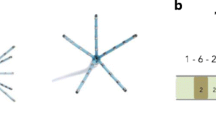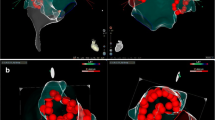Abstract
Purpose
A possible consequence of atrial fibrillation (AF) ablation is the occurrence of organized atrial tachycardias (ATs). ATs after AF ablation (ATAAF) may be more symptomatic than AF itself, thus necessitating catheter ablation. We evaluated the prognostic significance of clinical and invasive characteristics for long-term sinus rhythm (SR) maintenance following ATAAF ablation and assessed the effect of technological developments on these results.
Methods and results
Fifty-six consecutive patients with symptomatic ATAAF participated in the study and 114 ATAAF were revealed (2.04 ± 0.93 per patient). Sixty-eight ATAAF (60%) were macroreentrant and 33 (29%) were microreentrant circuits, while 13 (11%) were focal automatic tachycardias. The mean follow-up was 40 ± 18 months with 34 (61%) patients maintaining SR. Treatment with contact force (CF) catheters and EnSite AutoMap module (n = 11) showed significantly better AT/AF free rates at 1-year follow-up (10/11, 91%) compared with treatment using CF catheters but not AutoMap module (n = 13) (8/13, 62%) and treatment with use of neither of these modalities (n = 32) (16/32, 50%). Among patients with macroreentrant circuits around the mitral annulus or left atrial roof (n = 38), the group treated with complete linear lesions in anatomical isthmuses (n = 25) showed significantly better SR maintenance (19/25, 76%) compared with patients (n = 13) treated by empirical ablation in critical functional areas (6/13, 46%).
Conclusions
Technology advancement contributes substantially to long-term success in SR maintenance, by achieving detailed mapping and more effective ablation of ATAAF. The targeting of macroreentrant circuits by creating anatomical linear lesions appears to provide better results.












Similar content being viewed by others
References
Gerstenfeld EP, Callans DJ, Dixit S, Russo AM, Nayak H, Lin D, et al. Mechanisms of organized left atrial tachycardias occurring after pulmonary vein isolation. Circulation. 2004;110:1351–7.
Chugh A, Oral H, Lemola K, Hall B, Cheung P, Good E, et al. Prevalence, mechanisms, and clinical significance of macroreentrant atrial tachycardia during and following left atrial ablation for atrial fibrillation. Heart Rhythm. 2005;2:464–71.
Deisenhofer I, Estner H, Zrenner B, Schreieck J, Weyerbrock S, Hessling G, et al. Left atrial tachycardia after circumferential pulmonary vein ablation for atrial fibrillation: incidence, electrophysiological characteristics, and results of radiofrequency ablation. Europace. 2006;8:573–82.
Sawhney N, Anousheh R, Chen W, et al. Circumferential pulmonary vein ablation with additional linear ablation results in an increased incidence of left atrial flutter compared with segmental pulmonary vein isolation as an initial approach to ablation of paroxysmal atrial fibrillation. Circ Arrhythm Electrophysiol. 2010;3:243–8.
Rostock T, Drewitz I, Steven D, et al. Characterization, mapping, and catheter ablation of recurrent atrial tachycardias after stepwise ablation of long-lasting persistent atrial fibrillation. Circ Arrhythm Electrophysiol. 2010;3:160–9.
Wasmer K, Mönnig G, Bittner A, Dechering D, Zellerhoff S, Milberg P, et al. Incidence, characteristics, and outcome of left atrial tachycardias after circumferential antral ablation of atrial fibrillation. Heart Rhythm. 2012;9:1660–6.
Gerstenfeld EP, Marchlinski FE. Mapping and ablation of left atrial tachycardias occurring after atrial fibrillation ablation. Heart Rhythm. 2007;4:S65–72.
Morady F, Oral H, Chugh A. Diagnosis and ablation of atypical atrial tachycardia and flutter complicating atrial fibrillation ablation. Heart Rhythm. 2009;6:S29–32.
Sághy L, Tutuianu C, Szilágyi J. Atrial tachycardias following atrial fibrillation ablation. CurrCardiolRev. 2015;11:149–56.
Ptaszek L, Moon B, Rozen G, et al. Novel automated point collection software facilitates rapid, high-density electroanatomical mapping with multiple catheter types. J Cardiovasc Electrophysiol. 2018;29:186–95.
Bourier F, et al. New automatic mapping technology - accuracy and efficacy. Europace. 2017;19(Suppl 3):iii51 EHRA EUROPACE–CARDIOSTIM 2017 Scientific Sessions, June 18, 2017, Vienna, Austria. Abstract P316.
Moltrasio M, et al. A new improved 3D mapping system for left atrial ablation procedures: initial evaluation. Europace. 2017;19(Suppl 3):iii280 Presentation at EHRA EUROPACE –CARDIOSTIM 2017 Scientific Sessions, June 18, 2017, Vienna, Austria. Abstract P1413.
Calkins H, Hindricks G, Cappato R, Kim YH, Saad EB, Aguinaga L, et al. 2017HRS/EHRA/ECAS/APHRS/SOLAECE expert consensus statement on catheter and surgical ablation of atrial fibrillation. Europace. 2018;20(1):e1–e160. https://doi.org/10.1093/europace/eux274.
Ioannidis P, Zografos T, Vassilopoulos C, et al. Selective activation re-mapping reveals the mechanism in apparently unstable atrial tachycardias. J Atr Fibrillation. 2019;11:2152.
West TC, Landa JF. Minimal mass required for induction of a sustained arrhythmia in isolated atrial segments. Am J Phys. 1962;202:232–6. https://doi.org/10.1152/ajplegacy.1962.202.2.232.
Mamchur SE, Mamchur IN, Khomenko EA, Bokhan NS, Scherbinina DA. 'Electrical Exclusion' of a critical myocardial mass by extended pulmonary vein antrum isolation for persistent atrial fibrillation treatment. Interv Med Appl Sci. 2014;6(1):31–9. https://doi.org/10.1556/IMAS.6.2014.1.5.
Koyama T, Sekiguchi Y, Tada H, et al. Comparison of characteristics and significance of immediate versus early versus no recurrence of atrial fibrillation after catheter ablation. Am J Cardiol. 2009;103:1249–54.
Liang JJ, Elafros MA, Chik WW, et al. Early recurrence of atrial arrhythmias following pulmonary vein antral isolation: timing and frequency of early recurrences predicts long-term ablation success. HeartRhythm. 2015;12:2461–8.
Chae S, Oral H, Good E, et al. Atrial tachycardia after circumferential pulmonary vein ablation of atrial fibrillation: mechanistic insights, results of catheter ablation, and risk factors for recurrence. J Am Coll Cardiol. 2007;50:1781–7.
Chang SL, Tsao HM, Lin YJ, et al. Differentiating macroreentrant from focal atrial tachycardias occurred after circumferential pulmonary vein isolation. J Cardiovasc Electrophysiol. 2011;22:748–55.
Yokokawa M, Latchamsetty R, Ghanbari H, Belardi D, Makkar A, Roberts B, et al. Characteristics of atrial tachycardia due to small vs large reentrant circuits after ablation of persistent atrial fibrillation. Heart Rhythm. 2013;10:469–76.
Bun SS, Delassi T, Latcu DG, et al. A comparison between multipolar mapping and conventional mapping of atrial tachycardias in the context of atrial fibrillation ablation. ArchCardiovascDis. 2018;111:33–40.
Winkle R, Moskovitz R, Mead H, et al. Ablation of atypical atrial flutters using ultra high density-activation sequence mapping. J Interv Card Electrophysiol. 2017;48:177–84.
Barbhaiya CR, Kumar S, Ng J, Tedrow U, Koplan B, John R, et al. Overdrive pacing from downstream sites on multielectrode catheters to rapidly detect fusion and to diagnose macroreentrant atrial arrhythmias. Circulation. 2014;129:2503–10.
Takigawa M, Derval N, Frontera A, Martin R, Yamashita S, Cheniti G, et al. Revisiting anatomic macroreentrant tachycardia after atrial fibrillation ablation using ultrahigh-resolution mapping: implications for ablation. Heart Rhythm. 2018;15:326–33.
Hayashi T, Fukamizu S, Mitsuhashi T, Kitamura T, Aoyama Y, Hojo R, et al. Peri-mitral atrial tachycardia using the Marshall bundle epicardial connections. JACC Clin Electrophysiol. 2016;2:27–35.
Takigawa M, Derval N, Maury P, et al. Comprehensive multicenter study of the common isthmus in post-atrial fibrillation ablation multiple-loop atrial tachycardia. Circ Arrhythm Electrophysiol. 2018;11(6):e006019.
Kitamura T, Martin R, Denis A, et al. Characteristics of single-loop macroreentrant biatrial tachycardia diagnosed by ultrahigh-resolution mapping system. Circ Arrhythm Electrophysiol. 2018 Feb;11(2):e005558.
Frontera A, Mahajan R, Dallet C, Vlachos K, Kitamura T, Takigawa M, et al. Characterizing localized reentry with high-resolution mapping: evidence for multiple slow conducting isthmuses within the circuit. Heart Rhythm. 2019;16:679–85.
Yamashita S, Hooks D, Shah A, et al. Atrial tachycardias: cause or effect with ablation of persistent atrial fibrillation? J Cardiovasc Electrophysiol. 2018;29:274–83.
Sundaram S, Choe W, Jordan R, et al. Catheter ablation of atypical atrial flutter: a novel 3D anatomic mapping approach to quickly localize and terminate atypical atrial flutter. J Interv Card Electrophysiol. 2017;49:307–18.
Hermida Α, Kubala M, Traullé S, et al. Prevalence and predictive factors of left atrial tachycardia occurring after second-generation cryoballoon ablation of atrial fibrillation. J Cardiovasc Electrophysiol. 2018;29:46–54.
Bai R, Di Biase L, Mohanty P, et al. Ablation of perimitral flutter following catheter ablation of atrial fibrillation: impact on outcomes from a randomized study (PROPOSE). J Cardiovasc Electrophysiol. 2012;23:137–44.
Ullah W, McLean A, Tayebjee MH, Gupta D, Ginks MR, Haywood GA, et al. Randomized trial comparing pulmonary vein isolation using the SmartTouch catheter with or without real-time contact force data. Heart Rhythm. 2016;13:1761–7.
Conti S, Weerasooriya R, Novak P, Champagne J, Lim HE, Macle L, et al. Contact force sensing for ablation of persistent atrial fibrillation: a randomized, multicenter trial. Heart Rhythm. 2018;15:201–8.
Virk SA, Ariyaratnam J, Bennett RG, Kumar S. Updated systematic review and meta-analysis of the impact of contact force sensing on the safety and efficacy of atrial fibrillation ablation: discrepancy between observational studies and randomized control trial data. Europace. 2019;21:239–49.
Laţcu DG, Bun SS, Viera F, et al. Selection of critical isthmus in scar-related atrial tachycardia using a new automated ultrahigh resolution mapping system. Circ Arrhythm Electrophysiol. 2017;10:e004510.
Kautzner J, Neuzil P, Lambert H, Peichl P, Petru J, Cihak R, et al. EFFICAS II: optimization of catheter contact force improves outcome of pulmonary vein isolation for paroxysmal atrial fibrillation. Europace. 2015;17:1229–35.
Wójcik M, Berkowitsch A, Zaltsberg S, Hamm CW, Pitschner HF, Kuniss M, et al. Predictors of early and late left atrial tachycardia and left atrial flutter after catheter ablation of atrial fibrillation: long-term follow-up. Cardiol J. 2015;22:557–66.
Kawaji T, Shizuta S, Yamagami S, Aizawa T, Komasa A, Yoshizawa T, et al. Clinical utility of intravenous Nifekalant injection during radiofrequency catheter ablation for persistent atrial fibrillation. J Atr Fibrillation. 2018;11:1839.
Singh SM, D’ Avila A, Kim SJ, et al. Intraprocedural use of ibutilide to organize and guide ablation of complex fractionated atrial electrograms: preliminary assessment of a modified step-wise approach to ablation of persistent atrial fibrillation. J Cardiovasc Electrophysiol. 2010;21:608–16.
Author information
Authors and Affiliations
Corresponding author
Additional information
Publisher’s note
Springer Nature remains neutral with regard to jurisdictional claims in published maps and institutional affiliations.
Rights and permissions
About this article
Cite this article
Ioannidis, P., Zografos, T., Vassilopoulos, C. et al. The evolution of mapping and ablation techniques in the treatment of atrial tachycardias occurring after atrial fibrillation ablation. J Interv Card Electrophysiol 60, 493–511 (2021). https://doi.org/10.1007/s10840-020-00759-1
Received:
Accepted:
Published:
Issue Date:
DOI: https://doi.org/10.1007/s10840-020-00759-1




